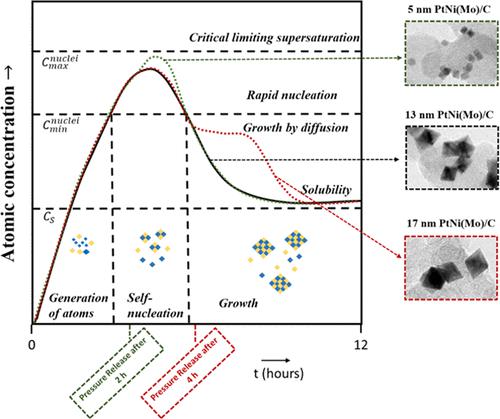当前位置:
X-MOL 学术
›
ACS Appl. Mater. Interfaces
›
论文详情
Our official English website, www.x-mol.net, welcomes your feedback! (Note: you will need to create a separate account there.)
Highly Active and Stable Large Mo-Doped Pt–Ni Octahedral Catalysts for ORR: Synthesis, Post-treatments, and Electrochemical Performance and Stability
ACS Applied Materials & Interfaces ( IF 9.5 ) Pub Date : 2022-06-22 , DOI: 10.1021/acsami.2c02397 Shlomi Polani 1 , Katherine E MacArthur 2 , Jiaqi Kang 1 , Malte Klingenhof 1 , Xingli Wang 1 , Tim Möller 1 , Raffaele Amitrano 1 , Raphaël Chattot 3 , Marc Heggen 2 , Rafal E Dunin-Borkowski 2 , Peter Strasser 1
ACS Applied Materials & Interfaces ( IF 9.5 ) Pub Date : 2022-06-22 , DOI: 10.1021/acsami.2c02397 Shlomi Polani 1 , Katherine E MacArthur 2 , Jiaqi Kang 1 , Malte Klingenhof 1 , Xingli Wang 1 , Tim Möller 1 , Raffaele Amitrano 1 , Raphaël Chattot 3 , Marc Heggen 2 , Rafal E Dunin-Borkowski 2 , Peter Strasser 1
Affiliation

|
Over the past decade, advances in the colloidal syntheses of octahedral-shaped Pt–Ni alloy nanocatalysts for use in fuel cell cathodes have raised our atomic-scale control of particle morphology and surface composition, which, in turn, helped raise their catalytic activity far above that of benchmark Pt catalysts. Future fuel cell deployment in heavy-duty vehicles caused the scientific priorities to shift from alloy particle activity to stability. Larger particles generally offer enhanced thermodynamic stability, yet synthetic approaches toward larger octahedral Pt–Ni alloy nanoparticles have remained elusive. In this study, we show how a simple manipulation of solvothermal synthesis reaction kinetics involving depressurization of the gas phase at different stages of the reaction allows tuning the size of the resulting octahedral nanocatalysts to previously unachieved scales. We then link the underlying mechanism of our approach to the classical “LaMer” model of nucleation and growth. We focus on large, annealed Mo-doped Pt–Ni octahedra and investigate their synthesis, post-synthesis treatments, and elemental distribution using advanced electron microscopy. We evaluate the electrocatalytic ORR performance and stability and succeed to obtain a deeper understanding of the enhanced stability of a new class of relatively large, active, and long-lived Mo-doped Pt–Ni octahedral catalysts for the cathode of PEMFCs.
中文翻译:

用于 ORR 的高活性和稳定的大型 Mo 掺杂 Pt-Ni 八面体催化剂:合成、后处理以及电化学性能和稳定性
在过去的十年中,用于燃料电池阴极的八面体形 Pt-Ni 合金纳米催化剂的胶体合成的进展提高了我们对粒子形态和表面组成的原子级控制,这反过来又有助于提高它们的催化活性。高于基准 Pt 催化剂。未来在重型车辆中部署燃料电池导致科学重点从合金颗粒活性转向稳定性。较大的颗粒通常提供增强的热力学稳定性,但合成更大的八面体 Pt-Ni 合金纳米颗粒的方法仍然难以捉摸。在这项研究中,我们展示了溶剂热合成反应动力学的简单操作,包括在反应的不同阶段对气相进行减压,从而可以将所得八面体纳米催化剂的尺寸调整到以前未达到的规模。然后,我们将我们方法的潜在机制与经典的“LaMer”成核和生长模型联系起来。我们专注于大型退火钼掺杂 Pt-Ni 八面体,并使用先进的电子显微镜研究它们的合成、合成后处理和元素分布。我们评估了电催化 ORR 性能和稳定性,并成功地更深入地了解了用于 PEMFC 阴极的新型相对较大、活性和长寿命的 Mo 掺杂 Pt-Ni 八面体催化剂的增强稳定性。然后,我们将我们方法的潜在机制与经典的“LaMer”成核和生长模型联系起来。我们专注于大型退火钼掺杂 Pt-Ni 八面体,并使用先进的电子显微镜研究它们的合成、合成后处理和元素分布。我们评估了电催化 ORR 性能和稳定性,并成功地更深入地了解了用于 PEMFC 阴极的新型相对较大、活性和长寿命的 Mo 掺杂 Pt-Ni 八面体催化剂的增强稳定性。然后,我们将我们方法的潜在机制与经典的“LaMer”成核和生长模型联系起来。我们专注于大型退火钼掺杂 Pt-Ni 八面体,并使用先进的电子显微镜研究它们的合成、合成后处理和元素分布。我们评估了电催化 ORR 性能和稳定性,并成功地更深入地了解了用于 PEMFC 阴极的新型相对较大、活性和长寿命的 Mo 掺杂 Pt-Ni 八面体催化剂的增强稳定性。
更新日期:2022-06-22
中文翻译:

用于 ORR 的高活性和稳定的大型 Mo 掺杂 Pt-Ni 八面体催化剂:合成、后处理以及电化学性能和稳定性
在过去的十年中,用于燃料电池阴极的八面体形 Pt-Ni 合金纳米催化剂的胶体合成的进展提高了我们对粒子形态和表面组成的原子级控制,这反过来又有助于提高它们的催化活性。高于基准 Pt 催化剂。未来在重型车辆中部署燃料电池导致科学重点从合金颗粒活性转向稳定性。较大的颗粒通常提供增强的热力学稳定性,但合成更大的八面体 Pt-Ni 合金纳米颗粒的方法仍然难以捉摸。在这项研究中,我们展示了溶剂热合成反应动力学的简单操作,包括在反应的不同阶段对气相进行减压,从而可以将所得八面体纳米催化剂的尺寸调整到以前未达到的规模。然后,我们将我们方法的潜在机制与经典的“LaMer”成核和生长模型联系起来。我们专注于大型退火钼掺杂 Pt-Ni 八面体,并使用先进的电子显微镜研究它们的合成、合成后处理和元素分布。我们评估了电催化 ORR 性能和稳定性,并成功地更深入地了解了用于 PEMFC 阴极的新型相对较大、活性和长寿命的 Mo 掺杂 Pt-Ni 八面体催化剂的增强稳定性。然后,我们将我们方法的潜在机制与经典的“LaMer”成核和生长模型联系起来。我们专注于大型退火钼掺杂 Pt-Ni 八面体,并使用先进的电子显微镜研究它们的合成、合成后处理和元素分布。我们评估了电催化 ORR 性能和稳定性,并成功地更深入地了解了用于 PEMFC 阴极的新型相对较大、活性和长寿命的 Mo 掺杂 Pt-Ni 八面体催化剂的增强稳定性。然后,我们将我们方法的潜在机制与经典的“LaMer”成核和生长模型联系起来。我们专注于大型退火钼掺杂 Pt-Ni 八面体,并使用先进的电子显微镜研究它们的合成、合成后处理和元素分布。我们评估了电催化 ORR 性能和稳定性,并成功地更深入地了解了用于 PEMFC 阴极的新型相对较大、活性和长寿命的 Mo 掺杂 Pt-Ni 八面体催化剂的增强稳定性。



























 京公网安备 11010802027423号
京公网安备 11010802027423号